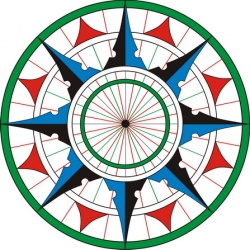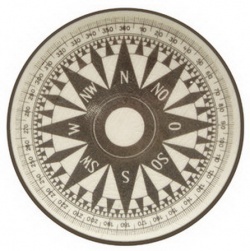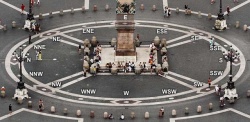Difference between revisions of "Cardinal direction"
m (Text replace - "example" to "example") |
|||
| Line 1: | Line 1: | ||
[[File:E_round.JPG|thumb|250px|]] | [[File:E_round.JPG|thumb|250px|]] | ||
<poem> | <poem> | ||
| − | The four [[cardinal directions]] or [[cardinal points]] are the [[directions]] of [[north]], [[east]], [[south]], and [[west]], commonly denoted by their initials: N, E, S, W. [[East]] and [[west]] are at right angles to [[north]] and [[south]], with [[east]] [[being]] in the clockwise [[direction]] of rotation from [[north]] and [[west]] [[being]] directly opposite [[east]]. Intermediate points between the four [[cardinal directions]] [[form]] the points of the compass. The intermediate ([[intercardinal]], or ordinal) [[directions]] are [[northeast]] (NE), [[southeast]] (SE), [[southwest]] (SW), and [[northwest]] (NW). | + | The four [[cardinal directions]] or [[cardinal points]] are the [[directions]] of [[north]], [[east]], [[south]], and [[west]], commonly denoted by their initials: N, E, S, W. [[East]] and [[west]] are at right angles to [[north]] and [[south]], with [[east]] [[being]] in the clockwise [[direction]] of rotation from [[north]] and [[west]] [[being]] directly {{Wiki|opposite}} [[east]]. Intermediate points between the four [[cardinal directions]] [[form]] the points of the compass. The intermediate ([[intercardinal]], or ordinal) [[directions]] are [[northeast]] (NE), [[southeast]] (SE), [[southwest]] (SW), and [[northwest]] (NW). |
On [[Earth]], upright observers facing [[north]] will have [[south]] behind them, [[east]] on their right, and [[west]] on their left. Most devices and methods for orientation therefore operate by finding [[north]] first, although any other [[direction]] is equally valid, if it can be reliably located. Several of these devices and methods are described below. | On [[Earth]], upright observers facing [[north]] will have [[south]] behind them, [[east]] on their right, and [[west]] on their left. Most devices and methods for orientation therefore operate by finding [[north]] first, although any other [[direction]] is equally valid, if it can be reliably located. Several of these devices and methods are described below. | ||
| Line 7: | Line 7: | ||
Germanic origin of names | Germanic origin of names | ||
| − | During the Migration Period, the Germanic languages' names for the [[cardinal directions]] entered the Romance languages, where they replaced the Latin names borealis (or septentrionalis) with north, australis (or meridionalis) with south, occidentalis with west and orientalis with east. It is possible that some northern [[people]] used the Germanic names for the intermediate [[directions]]. Medieval Scandinavian orientation would thus have involved a 45 degree rotation of [[cardinal directions]]. | + | During the Migration Period, the Germanic languages' names for the [[cardinal directions]] entered the Romance languages, where they replaced the Latin names borealis (or septentrionalis) with {{Wiki|north}}, australis (or meridionalis) with {{Wiki|south}}, occidentalis with {{Wiki|west}} and orientalis with {{Wiki|east}}. It is possible that some northern [[people]] used the Germanic names for the intermediate [[directions]]. Medieval Scandinavian orientation would thus have involved a 45 degree rotation of [[cardinal directions]]. |
| − | north (Proto-Germanic *norþ-) from the proto-Indo-European *nórto-s 'submerged' from the [[root]] *ner- 'left, below, to the left of the rising {{Wiki|sun}}' whence comes the {{Wiki|Ancient Greek}} name Nereus. | + | north (Proto-Germanic *norþ-) from the proto-Indo-European *nórto-s 'submerged' from the [[root]] *ner- 'left, below, to the left of the rising {{Wiki|sun}}' whence comes the {{Wiki|Ancient Greek}} [[name]] Nereus. |
east (*aus-t-) from the [[word]] for dawn. The proto-Indo-European [[form]] is *austo-s from the [[root]] is *aues- 'shine (red)'.[6] See Ēostre. | east (*aus-t-) from the [[word]] for dawn. The proto-Indo-European [[form]] is *austo-s from the [[root]] is *aues- 'shine (red)'.[6] See Ēostre. | ||
| − | south (*sunþ-), derived from proto-Indo-European *sú-n-to-s from the [[root]] *seu- 'seethe, boil'.[7] Cognate with this [[root]] is the [[word]] {{Wiki|Sun}}, thus "the region of the {{Wiki|Sun}}." | + | south (*sunþ-), derived from proto-Indo-European *sú-n-to-s from the [[root]] *seu- 'seethe, boil'.[7] [[Cognate]] with this [[root]] is the [[word]] {{Wiki|Sun}}, thus "the region of the {{Wiki|Sun}}." |
| − | west (*wes-t-) from a [[word]] for "evening." The proto-Indo-European [[form]] is *uestos from the [[root]] *ues- 'shine (red)',[8] itself a [[form]] of *aues-. Cognate with the [[root]] are the Latin words vesper and Vesta and the {{Wiki|Ancient Greek}} Hestia, Hesperus and Hesperides. | + | west (*wes-t-) from a [[word]] for "evening." The proto-Indo-European [[form]] is *uestos from the [[root]] *ues- 'shine (red)',[8] itself a [[form]] of *aues-. [[Cognate]] with the [[root]] are the Latin words vesper and Vesta and the {{Wiki|Ancient Greek}} Hestia, Hesperus and Hesperides. |
[[File:PBQ.jpg|thumb|250px|]] | [[File:PBQ.jpg|thumb|250px|]] | ||
Far East | Far East | ||
| Line 22: | Line 22: | ||
[[Tibet]] | [[Tibet]] | ||
| − | Dynastic {{Wiki|Chinese}} culture and some other Central Asian cultures [[view]] the center as a fifth principal [[direction]] hence the English translated term "Five [[Cardinal Points]]". Where it is different than the west, is that the term is used as a foundation for [[I Ching]], the [[Wu Xing]] and the five Naked-[[eye]] [[planets]]. | + | Dynastic {{Wiki|Chinese}} {{Wiki|culture}} and some other Central Asian cultures [[view]] the center as a fifth principal [[direction]] hence the English translated term "Five [[Cardinal Points]]". Where it is different than the {{Wiki|west}}, is that the term is used as a foundation for [[I Ching]], the [[Wu Xing]] and the five Naked-[[eye]] [[planets]]. |
In [[traditional]] {{Wiki|Chinese}} {{Wiki|astronomy}}, the zodiacal belt is divided into the four [[constellation]] groups corresponding to the four [[cardinal directions]]. | In [[traditional]] {{Wiki|Chinese}} {{Wiki|astronomy}}, the zodiacal belt is divided into the four [[constellation]] groups corresponding to the four [[cardinal directions]]. | ||
| − | Each [[direction]] is often identified with a color, and (at least in [[China]]) with a [[mythological]] creature of that color. Geographical or {{Wiki|ethnic}} terms may contain the name of the color instead of the name of the corresponding [[direction]]. These [[traditions]] were also carried west by the westward migration of the Turkic peoples. | + | Each [[direction]] is often identified with a {{Wiki|color}}, and (at least in [[China]]) with a [[mythological]] creature of that {{Wiki|color}}. Geographical or {{Wiki|ethnic}} terms may contain the [[name]] of the {{Wiki|color}} instead of the [[name]] of the corresponding [[direction]]. These [[traditions]] were also carried {{Wiki|west}} by the westward migration of the Turkic peoples. |
East: Green (青 "qīng" corresponds to both green and [[blue]]); Spring; [[Wood]] | East: Green (青 "qīng" corresponds to both green and [[blue]]); Spring; [[Wood]] | ||
| − | Qingdao (Tsingtao) "Green Island": a city on the east coast of [[China]] | + | Qingdao (Tsingtao) "Green Island": a city on the {{Wiki|east}} coast of [[China]] |
[[File:Are-edt.jpg|thumb|250px|]] | [[File:Are-edt.jpg|thumb|250px|]] | ||
South: Red; Summer; [[Fire]] | South: Red; Summer; [[Fire]] | ||
| − | Red [[River]] ({{Wiki|Asia}}): south of [[China]] | + | Red [[River]] ({{Wiki|Asia}}): {{Wiki|south}} of [[China]] |
West: White; Autumn; [[Metal]] | West: White; Autumn; [[Metal]] | ||
White Sheep Turkmen | White Sheep Turkmen | ||
| − | Belarus, meaning White Rus' or White Ruthenia | + | Belarus, [[meaning]] White Rus' or White Ruthenia |
North: Black; Winter; [[Water]] | North: Black; Winter; [[Water]] | ||
| − | Heilongjiang "Black [[Dragon]] [[River]]" province in Northeast [[China]], also the Amur [[River]] | + | Heilongjiang "Black [[Dragon]] [[River]]" province in {{Wiki|Northeast}} [[China]], also the Amur [[River]] |
Kara-Khitan Khanate "Black Khitans" who originated in Northern [[China]] | Kara-Khitan Khanate "Black Khitans" who originated in Northern [[China]] | ||
| − | {{Wiki|Black Sea}}: north of Anatolia | + | {{Wiki|Black Sea}}: {{Wiki|north}} of Anatolia |
Black Ruthenia | Black Ruthenia | ||
| Line 64: | Line 64: | ||
Tarascan | Tarascan | ||
| − | In Mesoamerica and North America, many [[traditional]] indigenous [[beliefs]] include four [[cardinal directions]] and a center. Each [[direction]] was associated with a color, which varied between groups but which generally corresponded to the hues of corn (green, black, red, white, and yellow). There seems to be no “preferred” way of assigning these colors; as shown in the table, great variety in color [[symbolism]] occurs even among cultures that are close neighbors geographically. | + | In Mesoamerica and {{Wiki|North}} {{Wiki|America}}, many [[traditional]] indigenous [[beliefs]] include four [[cardinal directions]] and a center. Each [[direction]] was associated with a {{Wiki|color}}, which varied between groups but which generally corresponded to the hues of corn (green, black, red, white, and yellow). There seems to be no “preferred” way of assigning these colors; as shown in the table, great variety in {{Wiki|color}} [[symbolism]] occurs even among cultures that are close neighbors geographically. |
[[Australia]] | [[Australia]] | ||
[[File:One-300.jpg|thumb|250px|]] | [[File:One-300.jpg|thumb|250px|]] | ||
| − | Some indigenous [[Australians]] have [[cardinal directions]] deeply embedded in their culture. For example, the Warlpiri [[people]] have a cultural [[philosophy]] deeply connected to the four [[cardinal directions]] and the Guugu Yimithirr [[people]] use [[cardinal directions]] rather than [[Relative]] [[direction]] even when indicating the position of an [[object]] close to their [[body]] (see Use of [[cardinal direction]] instead of [[relative]] [[direction]]). | + | Some indigenous [[Australians]] have [[cardinal directions]] deeply embedded in their {{Wiki|culture}}. For example, the Warlpiri [[people]] have a cultural [[philosophy]] deeply connected to the four [[cardinal directions]] and the Guugu Yimithirr [[people]] use [[cardinal directions]] rather than [[Relative]] [[direction]] even when indicating the position of an [[object]] close to their [[body]] (see Use of [[cardinal direction]] instead of [[relative]] [[direction]]). |
The precise [[direction]] of the [[cardinal points]] appear to have been important to some Aboriginal cultures (see aboriginal stone arrangements). | The precise [[direction]] of the [[cardinal points]] appear to have been important to some Aboriginal cultures (see aboriginal stone arrangements). | ||
| Line 74: | Line 74: | ||
Unique ([[non]]-[[compound]]) names of ordinal [[directions]] | Unique ([[non]]-[[compound]]) names of ordinal [[directions]] | ||
| − | In some languages, such as Finnish, Estonian and Breton, the ordinal [[directions]] have names that are not compounds of the names of the [[cardinal directions]] (as, for instance, northeast is [[compounded]] from north and east). In Finnish those are koillinen (northeast), kaakko (southeast), lounas (southwest), and luode (northwest). Compare with the [[non]]-[[compound]] names used for the numbers 11–19 in English (eleven, rather than *ten-one) and special names for one and a half and two and a half in Hindi. In {{Wiki|Japanese}}, there is the interesting situation that native {{Wiki|Japanese}} words (yamato kotoba, kun readings of kanji) are used for the [[cardinal directions]] (such as minami for 南, south), but borrowed {{Wiki|Chinese}} words (on readings of kanji) are used for ordinal [[directions]] (such as tō-nan for 東南, southeast, lit. "east-south"). In the Malay [[language]], adding laut (sea) to either east (timur) or west (barat) results in northeast or northwest, respectively, whereas adding [[daya]] to west (giving barat [[daya]]) results in southwest. However, southeast has a special [[word]]: tenggara. | + | In some languages, such as Finnish, Estonian and Breton, the ordinal [[directions]] have names that are not compounds of the names of the [[cardinal directions]] (as, for instance, {{Wiki|northeast}} is [[compounded]] from {{Wiki|north}} and {{Wiki|east}}). In Finnish those are koillinen ({{Wiki|northeast}}), kaakko ([[southeast]]), lounas ([[southwest]]), and luode ({{Wiki|northwest}}). Compare with the [[non]]-[[compound]] names used for the numbers 11–19 in English (eleven, rather than *ten-one) and special names for one and a half and two and a half in {{Wiki|Hindi}}. In {{Wiki|Japanese}}, there is the [[interesting]] situation that native {{Wiki|Japanese}} words (yamato kotoba, kun readings of kanji) are used for the [[cardinal directions]] (such as minami for 南, {{Wiki|south}}), but borrowed {{Wiki|Chinese}} words (on readings of kanji) are used for ordinal [[directions]] (such as tō-nan for 東南, [[southeast]], lit. "east-south"). In the Malay [[language]], adding laut (sea) to either {{Wiki|east}} (timur) or {{Wiki|west}} (barat) results in {{Wiki|northeast}} or {{Wiki|northwest}}, respectively, whereas adding [[daya]] to {{Wiki|west}} (giving barat [[daya]]) results in [[southwest]]. However, [[southeast]] has a special [[word]]: tenggara. |
| − | [[Sanskrit]] and other [[Indian]] languages that borrow from it use the names of the [[gods]] associated with each [[direction]]: east ([[Indra]]), southeast ([[Agni]]), south ([[Yama]]/[[Dharma]]), southwest (Nirrti), west ([[Varuna]]), northwest ([[Vayu]]), north ([[Kubera]]/[[Heaven]]) and northeast (Ishana/{{Wiki|Shiva}}). North is associated with the [[Himalayas]] and [[heaven]] while the south is associated with the underworld or land of the fathers (Pitr [[loka]]). The [[directions]] are named by adding "[[disha]]" to the names of each [[god]] or entity: e.g. Indradisha ([[direction]] of [[Indra]]) or Pitrdisha ([[direction]] of the forefathers i.e. south). | + | [[Sanskrit]] and other [[Indian]] languages that borrow from it use the names of the [[gods]] associated with each [[direction]]: {{Wiki|east}} ([[Indra]]), [[southeast]] ([[Agni]]), {{Wiki|south}} ([[Yama]]/[[Dharma]]), [[southwest]] (Nirrti), {{Wiki|west}} ([[Varuna]]), {{Wiki|northwest}} ([[Vayu]]), {{Wiki|north}} ([[Kubera]]/[[Heaven]]) and {{Wiki|northeast}} (Ishana/{{Wiki|Shiva}}). {{Wiki|North}} is associated with the [[Himalayas]] and [[heaven]] while the {{Wiki|south}} is associated with the {{Wiki|underworld}} or land of the fathers (Pitr [[loka]]). The [[directions]] are named by adding "[[disha]]" to the names of each [[god]] or {{Wiki|entity}}: e.g. Indradisha ([[direction]] of [[Indra]]) or Pitrdisha ([[direction]] of the forefathers i.e. south). |
[[Order]] of [[directions]] | [[Order]] of [[directions]] | ||
This section requires expansion. (September 2010) | This section requires expansion. (September 2010) | ||
| − | While the [[directions]] can be listed in any [[order]], most formally in clockwise or counterclockwise [[order]], starting from some point (such as NESW, or, following the {{Wiki|sun}} from daybreak in the northern hemisphere, ESWN), different languages conventionally use different orders, often using pairs of opposite [[directions]]. In English, the conventional [[order]] of the [[directions]] is "north, south, east, and west" (NSEW = N/S + E/W). In {{Wiki|Japanese}}, most common is EWSN (東西南北 = E/W + S/N), and east-west (東西) is idiomatic for “everywhere, in all parts”; {{Wiki|Japan}} is located at the extreme east of {{Wiki|Eurasia}}. | + | While the [[directions]] can be listed in any [[order]], most formally in clockwise or counterclockwise [[order]], starting from some point (such as NESW, or, following the {{Wiki|sun}} from daybreak in the northern hemisphere, ESWN), different languages conventionally use different orders, often using pairs of {{Wiki|opposite}} [[directions]]. In English, the {{Wiki|conventional}} [[order]] of the [[directions]] is "{{Wiki|north}}, {{Wiki|south}}, {{Wiki|east}}, and {{Wiki|west}}" (NSEW = N/S + E/W). In {{Wiki|Japanese}}, most common is EWSN (東西南北 = E/W + S/N), and east-west (東西) is idiomatic for “everywhere, in all parts”; {{Wiki|Japan}} is located at the extreme {{Wiki|east}} of {{Wiki|Eurasia}}. |
Non-compass directional systems | Non-compass directional systems | ||
| − | Use of the compass [[directions]] is common and deeply embedded in European culture, and also in {{Wiki|Chinese}} culture (see South Pointing Chariot). Some other cultures make greater use of other referents, such as towards the sea or towards the mountains (Hawaii, Bali), or upstream and downstream (most notably in ancient Egypt, also in the Yurok and Karuk languages). Lengo (Guadalcanal, Solomon Islands) has four non-compass [[directions]]: landward, seaward, upcoast, and downcoast. | + | Use of the compass [[directions]] is common and deeply embedded in European {{Wiki|culture}}, and also in {{Wiki|Chinese}} {{Wiki|culture}} (see {{Wiki|South}} Pointing Chariot). Some other cultures make [[greater]] use of other referents, such as towards the sea or towards the mountains (Hawaii, Bali), or upstream and downstream (most notably in ancient {{Wiki|Egypt}}, also in the Yurok and Karuk languages). Lengo (Guadalcanal, Solomon Islands) has four non-compass [[directions]]: landward, seaward, upcoast, and downcoast. |
</poem> | </poem> | ||
{{W}} | {{W}} | ||
[[Category:Astrology]] | [[Category:Astrology]] | ||
Revision as of 09:21, 9 September 2013
The four cardinal directions or cardinal points are the directions of north, east, south, and west, commonly denoted by their initials: N, E, S, W. East and west are at right angles to north and south, with east being in the clockwise direction of rotation from north and west being directly opposite east. Intermediate points between the four cardinal directions form the points of the compass. The intermediate (intercardinal, or ordinal) directions are northeast (NE), southeast (SE), southwest (SW), and northwest (NW).
On Earth, upright observers facing north will have south behind them, east on their right, and west on their left. Most devices and methods for orientation therefore operate by finding north first, although any other direction is equally valid, if it can be reliably located. Several of these devices and methods are described below.
Germanic origin of names
During the Migration Period, the Germanic languages' names for the cardinal directions entered the Romance languages, where they replaced the Latin names borealis (or septentrionalis) with north, australis (or meridionalis) with south, occidentalis with west and orientalis with east. It is possible that some northern people used the Germanic names for the intermediate directions. Medieval Scandinavian orientation would thus have involved a 45 degree rotation of cardinal directions.
north (Proto-Germanic *norþ-) from the proto-Indo-European *nórto-s 'submerged' from the root *ner- 'left, below, to the left of the rising sun' whence comes the Ancient Greek name Nereus.
east (*aus-t-) from the word for dawn. The proto-Indo-European form is *austo-s from the root is *aues- 'shine (red)'.[6] See Ēostre.
south (*sunþ-), derived from proto-Indo-European *sú-n-to-s from the root *seu- 'seethe, boil'.[7] Cognate with this root is the word Sun, thus "the region of the Sun."
west (*wes-t-) from a word for "evening." The proto-Indo-European form is *uestos from the root *ues- 'shine (red)',[8] itself a form of *aues-. Cognate with the root are the Latin words vesper and Vesta and the Ancient Greek Hestia, Hesperus and Hesperides.
Far East
Asia
China
Ainu
Turkic
Kalmyks —
Tibet
Dynastic Chinese culture and some other Central Asian cultures view the center as a fifth principal direction hence the English translated term "Five Cardinal Points". Where it is different than the west, is that the term is used as a foundation for I Ching, the Wu Xing and the five Naked-eye planets.
In traditional Chinese astronomy, the zodiacal belt is divided into the four constellation groups corresponding to the four cardinal directions.
Each direction is often identified with a color, and (at least in China) with a mythological creature of that color. Geographical or ethnic terms may contain the name of the color instead of the name of the corresponding direction. These traditions were also carried west by the westward migration of the Turkic peoples.
East: Green (青 "qīng" corresponds to both green and blue); Spring; Wood
Qingdao (Tsingtao) "Green Island": a city on the east coast of China
South: Red; Summer; Fire
Red River (Asia): south of China
West: White; Autumn; Metal
White Sheep Turkmen
Belarus, meaning White Rus' or White Ruthenia
North: Black; Winter; Water
Heilongjiang "Black Dragon River" province in Northeast China, also the Amur River
Kara-Khitan Khanate "Black Khitans" who originated in Northern China
Black Sea: north of Anatolia
Black Ruthenia
Center: Yellow; Earth
Huangshan "Yellow Mountain" in central China
Golden Horde: "Central Army" of the Mongols
Americas
America N E S W C
Apache —
Aztec
Cherokee
Lakota
Mayan
Navajo —
Sioux —
Tarascan
In Mesoamerica and North America, many traditional indigenous beliefs include four cardinal directions and a center. Each direction was associated with a color, which varied between groups but which generally corresponded to the hues of corn (green, black, red, white, and yellow). There seems to be no “preferred” way of assigning these colors; as shown in the table, great variety in color symbolism occurs even among cultures that are close neighbors geographically.
Australia
Some indigenous Australians have cardinal directions deeply embedded in their culture. For example, the Warlpiri people have a cultural philosophy deeply connected to the four cardinal directions and the Guugu Yimithirr people use cardinal directions rather than Relative direction even when indicating the position of an object close to their body (see Use of cardinal direction instead of relative direction).
The precise direction of the cardinal points appear to have been important to some Aboriginal cultures (see aboriginal stone arrangements).
Many aboriginal languages contain words for the usual four cardinal directions, but some contain words for 5 or even 6 cardinal directions.
Unique (non-compound) names of ordinal directions
In some languages, such as Finnish, Estonian and Breton, the ordinal directions have names that are not compounds of the names of the cardinal directions (as, for instance, northeast is compounded from north and east). In Finnish those are koillinen (northeast), kaakko (southeast), lounas (southwest), and luode (northwest). Compare with the non-compound names used for the numbers 11–19 in English (eleven, rather than *ten-one) and special names for one and a half and two and a half in Hindi. In Japanese, there is the interesting situation that native Japanese words (yamato kotoba, kun readings of kanji) are used for the cardinal directions (such as minami for 南, south), but borrowed Chinese words (on readings of kanji) are used for ordinal directions (such as tō-nan for 東南, southeast, lit. "east-south"). In the Malay language, adding laut (sea) to either east (timur) or west (barat) results in northeast or northwest, respectively, whereas adding daya to west (giving barat daya) results in southwest. However, southeast has a special word: tenggara.
Sanskrit and other Indian languages that borrow from it use the names of the gods associated with each direction: east (Indra), southeast (Agni), south (Yama/Dharma), southwest (Nirrti), west (Varuna), northwest (Vayu), north (Kubera/Heaven) and northeast (Ishana/Shiva). North is associated with the Himalayas and heaven while the south is associated with the underworld or land of the fathers (Pitr loka). The directions are named by adding "disha" to the names of each god or entity: e.g. Indradisha (direction of Indra) or Pitrdisha (direction of the forefathers i.e. south).
Order of directions
This section requires expansion. (September 2010)
While the directions can be listed in any order, most formally in clockwise or counterclockwise order, starting from some point (such as NESW, or, following the sun from daybreak in the northern hemisphere, ESWN), different languages conventionally use different orders, often using pairs of opposite directions. In English, the conventional order of the directions is "north, south, east, and west" (NSEW = N/S + E/W). In Japanese, most common is EWSN (東西南北 = E/W + S/N), and east-west (東西) is idiomatic for “everywhere, in all parts”; Japan is located at the extreme east of Eurasia.
Non-compass directional systems
Use of the compass directions is common and deeply embedded in European culture, and also in Chinese culture (see South Pointing Chariot). Some other cultures make greater use of other referents, such as towards the sea or towards the mountains (Hawaii, Bali), or upstream and downstream (most notably in ancient Egypt, also in the Yurok and Karuk languages). Lengo (Guadalcanal, Solomon Islands) has four non-compass directions: landward, seaward, upcoast, and downcoast.




